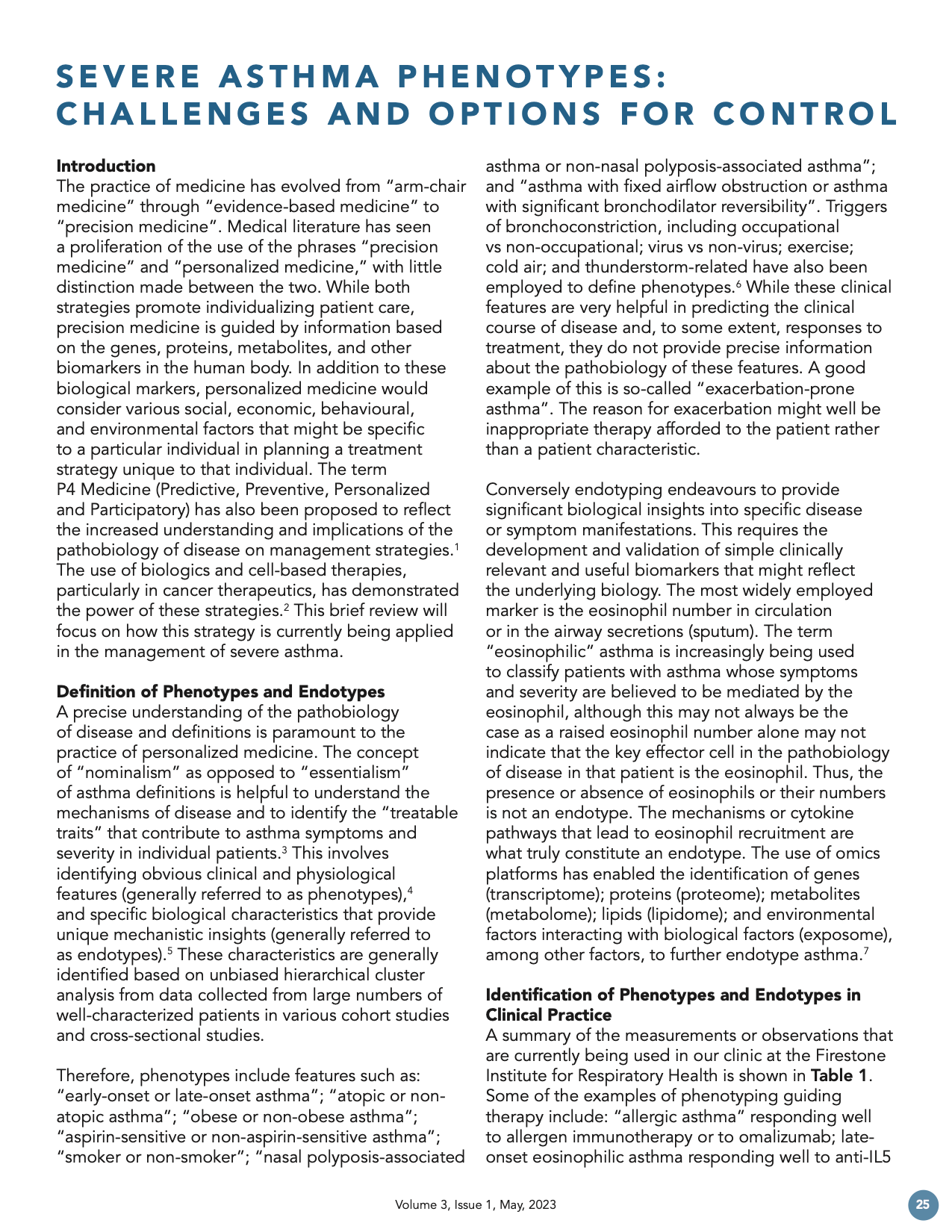Severe Asthma Phenotypes: Challenges and Options for Control
DOI:
https://doi.org/10.58931/cait.2023.3143Abstract
The practice of medicine has evolved from “arm-chair medicine” through “evidence-based medicine” to “precision medicine”. Medical literature has seen a proliferation of the use of the phrases “precision medicine” and “personalized medicine,” with little distinction made between the two. While both strategies promote individualizing patient care, precision medicine is guided by information based on the genes, proteins, metabolites, and other biomarkers in the human body. In addition to these biological markers, personalized medicine would consider various social, economic, behavioural, and environmental factors that might be specific to a particular individual in planning a treatment strategy unique to that individual. The term P4 Medicine (Predictive, Preventive, Personalized and Participatory) has also been proposed to reflect the increased understanding and implications of the pathobiology of disease on management strategies.1 The use of biologics and cell-based therapies, particularly in cancer therapeutics, has demonstrated the power of these strategies.2 This brief review will focus on how this strategy is currently being applied in the management of severe asthma.
References
Schüssler-Fiorenza Rose SM, Contrepois K, Moneghetti KJ, Zhou W, Mishra T, Mataraso S, et al. A longitudinal big data approach for precision health. Nat Med. 2019; 25:792-804.
Hood L, Friend SH. Predictive, personalized, preventive, participatory (P4) cancer medicine. Nature Rev Clin Oncol. 2011;8:184-87.
Hargreave FE, Nair P. The definition and diagnosis of asthma. Clin Exp Allergy. 2009;39:1652-8.
Haldar P, Pavord ID, Shaw DE, Berry MA, Thomas M, Brightling CE, et al. Cluster analysis and clinical asthma phenotypes. Am J Respir Crit Care Med. 2008;178:218-224.
Lötvall J, Akdis CA, Bacharier LB, Bjermer L, Casale TB, Custovic A, et al. Asthma endotypes: a new approach to classification of disease entities within the asthma syndrome. J Allergy Clin Immunol. 2011;127:355-60.
Hekking PP, Bel EH. Developing and emerging clinical asthma phenotypes. J Allergy Clin Immunol Pract. 2014;2:671-80.
Wheelock CE, Goss VM, Balgoma D, Nicholas B, Brandsma J, Skipp PJ, et al. U-BIOPRED Study Group. Application of ‘omics technologies’ to biomarker discovery in inflammatory lung diseases. Eur Respir J. 2013;42:802-25.
Lim HF, Nair P. Airway Inflammation and Inflammatory Biomarkers. Semin Respir Crit Care Med. 2018;39:56-63.
Schleich FN, Seidel L, Sele J, Manise M, Quaedvlieg V, Michils A, et al. Exhaled nitric oxide thresholds associated with a sputum eosinophil count ≥3% in a cohort of unselected patients with asthma. Thorax. 2010;65:1039-44.
Diamant Z, Vijverberg S, Alving K, Bakirtas A, Bjermer L, Custovic A, et al. Toward clinically applicable biomarkers for asthma: An EAACI position paper. Allergy. 2019;74:1835-1851.
National Institute for Health and Care Excellence (NICE). Asthma: diagnosis, monitoring and chronic asthma management. Accessed 2023 Feb 28. Available from: https://www.nice.org.uk/guidance/indevelopment/gid-ng10186/documents.
Agache I, Akdis CA, Akdis M, Canonica GW, Casale T, Chivato T, et al. EAACI Biologicals Guidelines-Recommendations for severe asthma. Allergy. 2021;76:14-44.
FitzGerald JM, Lemiere C, Lougheed MD, et al. Recognition and management of severe asthma: A Canadian Thoracic Society position statement. Can J Respir Crit Care Sleep Med. 2017;1:199-221.
Virchow JC, Backer V, Kuna P, Prieto L, Nolte H, Villesen HH, et al. Efficacy of a House Dust Mite Sublingual Allergen Immunotherapy Tablet in Adults With Allergic Asthma: A Randomized Clinical Trial. JAMA. 2016;315:1715-25.
Jayaram L, Pizzichini MM, Cook RJ, Boulet LP, Lemière C, Pizzichini E, et al. Determining asthma treatment by monitoring sputum cell counts: effect on exacerbations. Eur Respir J. 2006;27:483-94.
Calhoun WJ, Ameredes BT, King TS, Icitovic N, Bleecker ER, Castro M, et al. Comparison of physician-, biomarker-, and symptom-based strategies for adjustment of inhaled corticosteroid therapy in adults with asthma: the BASALT randomized controlled trial. Asthma Clinical Research Network of the National Heart, Lung, and Blood Institute. JAMA. 2012;308:987-97.
McNicholl DM, Stevenson M, McGarvey LP, Heaney LG. The utility of fractional exhaled nitric oxide suppression in the identification of nonadherence in difficult asthma. Am J Respir Crit Care Med. 2012;186:1102-8.
Rupani H, Murphy A, Bluer K, Renwick C, McQuitty P, Jackson DJ, et al. Biologics in severe asthma: Which one, When and Where? Clin Exp Allergy. 2021;51:1225-8.
Wechsler ME, Menzies-Gow A, Brightling CE, Kuna P, Korn S, Welte T, et al. Evaluation of the oral corticosteroid-sparing effect of tezepelumab in adults with oral corticosteroid-dependent asthma (SOURCE): a randomised, placebo-controlled, phase 3 study. Lancet Respir Med. 2022;10:650-60.
Aziz-Ur-Rehman A, Dasgupta A, Kjarsgaard M, Hargreave FE, Nair P. Sputum cell counts to manage prednisone-dependent asthma: effects on FEV1 and eosinophilic exacerbations. Allergy Asthma Clin Immunol. 2017;13:17. doi:10.1186/s13223-017-0190-0
Nair P, O’Byrne PM. Medical algorithms: Approach to adult asthma exacerbations. Allergy 2021; 76:3556-9.
Koenderman L, Hassani M, Mukherjee M, Nair P. Monitoring eosinophils to guide therapy with biologics in asthma: does the compartment matter? Allergy. 2021;76:1294-7.
Svenningsen S, Haider E, Boylan C, Mukherjee M, Eddy RL, Capaldi DPI, et al. CT and Functional MRI to Evaluate Airway Mucus in Severe Asthma. Chest. 2019;155:1178-9.
Venegas Garrido C, Mukherjee M, Bhalla A, Nair P. Airway autoimmunity, asthma exacerbations, and response to biologics. Clin Exp Allergy. 2022;52:1365-8.
Poznanski SM, Portillo A, Mukherjee M, Bhalla A, Son K, Ashkar AA, et al. Benralizumab’s anti-eosinophil efficacy may be decreased by impaired NK cell activity. Eur Respir J. 2022;59:2102210. doi:10.1183/13993003.02210-2021
Nair P, Surette MG, Virchow JC. Neutrophilic asthma: misconception or misnomer? Lancet Respir Med. 2021;9:441-3.
Ali MM, Wolfe MG, Mukherjee M, Radford K, Patel Z, White D, et al. A sputum bioassay for airway eosinophilia using an eosinophil peroxidase aptamer. Sci Rep. 2022;12:22476.
Wolfe MG, Zhang Q, Hui C, Radford K, Nair P, Brennan JD. Development of a functional point-of-need diagnostic for myeloperoxidase detection to identify neutrophilic bronchitis. Analyst. 2016;141:6438-43.
Ray A, Das J, Wenzel SE. Determining asthma endotypes and outcomes: Complementing existing clinical practice with modern machine learning. Cell Rep Med. 2022;3:100857. doi:10.1016/j.xcrm.2022.100857
Mazein A, Ivanova O, Balaur I, Ostaszewski M, Berzhitskaya V, Serebriyskaya T et al, AsthmaMap: An interactive knowledge repository for mechanisms of asthma. U-BIOPRED Study Group, eTRIKS Consortium. J Allergy Clin Immunol. 2021;147:853-6.
Bush A, Fitzpatrick AM, Saglani S, Anderson WC 3rd, Szefler SJ. Difficult-to-Treat Asthma Management in School-Age Children. J Allergy Clin Immunol Pract. 2022;10:359-75.

